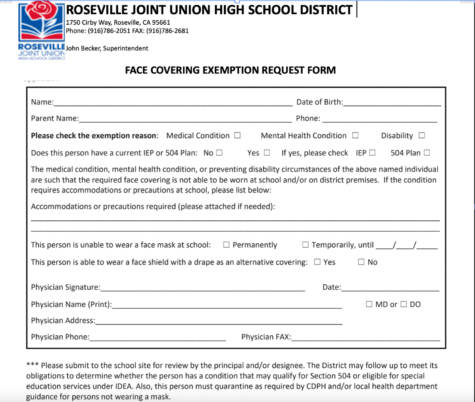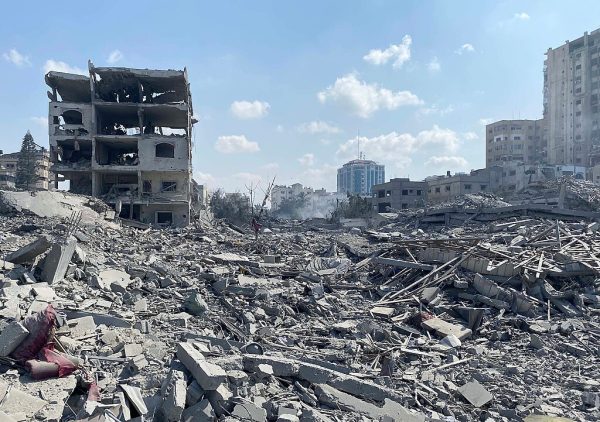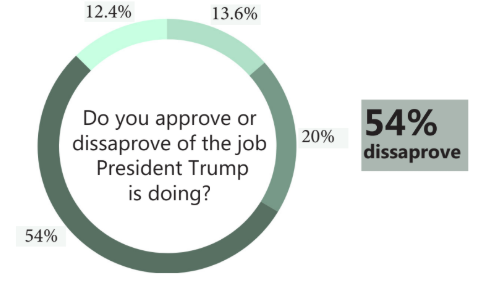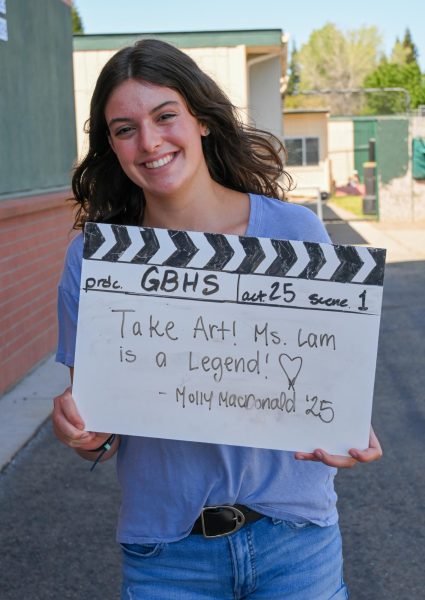Mental health deteriorates as the pandemic progresses
Many students at GBHS agree with the sentiment that it is difficult to maintain a healthy mental state under current circumstances.
Students at GBHS can pick up rocks with uplifting messages from the rock garden to help relieve stress.
COVID-19 hitting the world has undoubtedly caused great havoc. Death seemed to be inevitable and fate would be far out of reach. Mental illness became the common theme of this pandemic and the stumbling block for the majority.
“I definitely say mentally (I’ve experienced) a decline and I think that goes for…most people just because a lot of things were lost and it was just a really big change that no one was expecting,” said Olivia Galvan, a senior at Granite Bay High School. “It was harder trying to stay positive and trying to see the good (in) things.”
At the beginning of the pandemic, fear and concern created an intense atmosphere for many students.
“I would definitely say that there are times where my mental health (is) really bad and it would be better if…things were back to normal,” said Zelli Hinkey, a junior enrolled in the Roseville Virtual Learning Academy.
The National Center for Biotechnology Information reported 91% of students in school and college were negatively impacted after the closure of schools. Followed by closures would be student isolation which linked to ambivalence and anxiety along with contributing to the disruption of education, athletics, and opportunities for socialization.
“I think about how everyone’s being robbed of their precious time just rotting away in their house,” said a senior girl who asked to remain anonymous. “I get sad.”
The anonymous senior girl is far from alone when it comes to the sense of isolation she’s experiencing.
As of Jan. 21, 2021, Kaiser Family Foundation found an average of 41% of adults self-reported symptoms of anxiety and/or a depressive disorder. 18% of individuals (including people with or without a psychiatric diagnosis in the past) reported being diagnosed with a mental health disorder such as anxiety or mood disorders after COVID-19 was detected.
“In March of last year right when the pandemic became really serious and…a worldwide worry, I was diagnosed with depression,” said Sophia Shaw, a junior at Visions in Education.
The Centers for Disease Control and Prevention reported 40% of U.S. adults struggled with mental illness or substance abuse in late June, just three months after closures and social distancing began to impact Americans. This percentage did not include the 13% of the population that started or increased in substance abuse. Some students expressed feeling lost during this time and disclosed turning to substance abuse as a way of dealing with the pain.
“I resorted to hard drugs … partying… crappy friends and hyperactive unprotected sex to distract myself from my depression,” the anonymous senior girl said.
After months passed by, however, anonymous senior girl made the decision to turn her life around.
“I also learned things about myself I didn’t know and it has helped me grow mentally,” she said. “I ended up getting bored and running away and couch hopping. That has put me in really rough situations. Luckily, I moved back in with my parents after many months and I’ve taken a step back and realized I need to fix my life and get sober and cut off all my friends who were encouraging bad habits.”
During the Jan. 26 board meeting, the trustees decided to continue five days of in-person instruction per week. In part, this was an attempt to address the increase in stress and mental illness exacerbated by the interruptions to students’ schedules. Kendaylin Smith, a student representative from Antelope High School said it was important to consider the students who are still continuing school through Zoom.
“I want to make sure they don’t get left behind,” Smith said. “They are the ones hurting the most. … I think it would be a good idea for us to have some programs for them to reach out and get help for their mental health. “…There is no reason to not have Zoom, there are always going to be students quarantining.”
This concern applies to students like Hinkey who participates in RSVLA.
“I don’t get the opportunity to interact with people,” Hinkey said. “It’s definitely limited my (social interaction) just because I haven’t really been able to have as many opportunities. I feel like (online classes have) given me a lot of anxiety.
Lucky students who are using the RSVLA system can contact the Wellness Center for services as well as students attending on campus.
“The Wellness Center provides a range of support services for students which include individual therapy, group therapy, drop-in services as needed, attendance support, substance use prevention and education, connection to community resources, collaboration with outside providers and therapists, referrals to community agencies,” said Mental Health associate Emily Belgarde. “Students are able to use their time in therapy to process a variety of topics including, stress/anxiety, low mood/depression, family dynamics, substance use, grief and loss, LGBTQ+ related topics, self-esteem, and many others,” Belgarde said.
Students online who want access to Wellness Center can use the link and once received, wellness staff will reach out to the student to schedule an appointment.
Some students who have returned to campus also said they have been on edge because of the possibility of being exposed to COVID.
“My anxiety skyrocketed (when I was at) school,” Smith said. “I’ve seen a bunch of students not wearing masks before class.”
The senior girl agreed that returning back to school is emotionally stressful.
“Luckily, I don’t have to go on campus … because the anxiety that would give me is unreal,” The YEAR girl said. “It’s always been bad, but it has definitely gotten much much much worse since COVID started.”
Despite the negative impact of these times, people have benefitted from seeking support from one another.
“My ability to interact with others has absolutely changed after being in two mental hospitals,” Shaw said. “It absolutely humbled me. The people there are just very nice and loving. It’s like a big family once you get comfortable and you guys are all going through the same thing. You can literally talk to anyone and they will know what you’re talking about and they will know how to help you or they will give you some of their opinions.”
Students have also taken advantage of the opportunities for self-awareness and reflection quarantine offers.
“I’ve really got myself put together,” said Lakeesha Selverntam, a sophomore at GBHS. “I worked on things I never had time to do when normal school was going on, and it feels great. I’ve been working out a lot over quarantine and it’s definitely boosted my mood and energy.”
After the long online “vacation”, most students were excited to come back to campus to finally connect with their friends in person.
“I really enjoyed (coming back),” Galvan said. “I just like being on campus and being able to see my teachers still teaching from powerpoints or something (on top of) being able to be in class and talk to the person next to me if I have a super quick question or raise my hand in class.
I get to see my friends (and) it’s a lot better than I expected. I thought going back would be kind of like a prison.”
COVID-19 has plagued many lives with hardship. It is important to check on loved ones during this time.
If you or someone you may know is experiencing suicidal thoughts or attempts, contact a trusted adult, peer, or the wellness center. NATIONAL PREVENTION SUCIDE LIFELINE CHAT/ NUMBER: https://suicidepreventionlifeline.org/chat/
(800)-273- 8255
NATIONAL PREVENTION SUICIDE WEBSITE : https://suicidepreventionlifeline.org
Trinity is a junior, and this is her first year on the Gazette staff.















Jenny • Apr 22, 2022 at 8:38 am
I totally agree with the article, the quarantine caused lots of stress to the students and the parents. Especially during the “zoom classes period”, our students haven’t got any chance to talk to their peers, classmates, nor friends. Instead, the students only get to stay home and hang out with family members and start exploring socializing online. And some dangerous side of the internet, somehow leads to depression since stresses were not being expressed correctly and maybe even came from the social medias…The article is excellent, it spreads the importance of student mental health, and made the ones that are experiencing this not alone.
Jenny • Apr 22, 2022 at 8:35 am
I totally agree with the article, the quarantine caused lots of stress to the students and the parents. Especially during the “zoom classes period”, our students haven’t gotten any chance to talk to their peers, classmates, nor friends. Instead, the students only get to stay home and hang out with family members and some might even get attached to socializing online. The dangerous side of internate were not helpful in expressing feelings sometimes. Which somehow leads to depression since stresses were not being expressed correctly and maybe even came from the social medias…The article is excellent, it spreads the importance of mental health and stated many students has gone through this to make the students that are experiencing this not alone.
jashan singh • Sep 17, 2021 at 10:18 am
I love how relatable this article is to many people! It instantly creates a connection. Mental health should really be talked about more.
ria nolan • Apr 9, 2021 at 10:31 am
I really liked this article because of how relatable it is. Glad to hear I’m not alone during these times.
Bao Nguyen • Apr 9, 2021 at 10:31 am
I agree with this, mental health is important and we need to talk about it more.
Sarah Alami • Apr 9, 2021 at 7:55 am
I have never struggled from depression or anxiety thankfully, but I completely resonate with a lot of things said in this article. It was definitely hard on everyone’s mental health no matter who you are, to have to be in self isolation.
Eniola Okon • Apr 9, 2021 at 7:55 am
This is great! I believe that mental health, especially after such a detrimental and international occurrence, is so important to talk about. This past year has been difficult for everyone, and hearing the emotional turbulence others have gone through truly saddens me. Great job! This is a relatable and essential article.